Phaeton body
A phaeton is a style of open automobile without any fixed weather protection, which was popular from the 1900s until the 1930s. It is an automotive equivalent of the horse-drawn fast, lightweight phaeton carriage.[1]


.jpg.webp)
A popular style in the US from the mid–1920s and continuing into the first half of the 1930s was the dual cowl phaeton, with a cowl separating the rear passengers from the driver and front passenger.[2]
Phaetons fell from favour when closed cars and convertible body styles became widely available during the 1930s. Eventually, the term "phaeton" became so widely and loosely applied that almost any vehicle with two axles and a row or rows of seats across the body could be called a phaeton.[3] Convertibles and pillarless hardtops were sometimes marketed as "phaetons" after actual phaetons were phased out.
History
The term phaeton had historically described a light, open four-wheeled carriage. When automobiles arrived it was applied to a light two-seater with minimal coachwork. The term was interchangeable with spyder, derived from a light form of phaeton carriage known as a spider.[4] Originally meant to denote a faster and lighter vehicle than a touring car, the two terms eventually became interchangeable.[5]
A detachable folding or rigid roof could be added before a drive in preparation for inclement weather, and side curtains or screens could be installed once the roof was in place. This was mainly temporary and partial relief rather than the more permanent, watertight protection offered by a convertible. As a result, a phaeton was much lighter than the sturdier, weather-ready convertible. Since the body was entirely open, it was easy to add or remove an extra row of seating where space had been left in the original construction.
A phaeton differs from a convertible in having no winding or sliding windows in the doors or the body.[6]
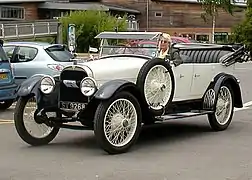 1917 Hudson phaeton
1917 Hudson phaeton Isotta Fraschini Tipo 8 Sala
Isotta Fraschini Tipo 8 Sala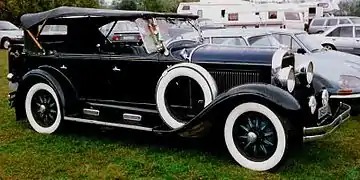 1930 Studebaker
1930 Studebaker 1930 Ford Model A
1930 Ford Model A
 Toyota AB phaeton
Toyota AB phaeton
Doubles and triples
There were also double phaetons, with two rows of seats, triple phaetons, and closed phaetons.[4][3]
After 1912, American use of the term began to be most closely associated with the "triple phaeton" body configurations that had room for three rows of seats, whether all three were installed or not. This also led to the term "phaeton" becoming similar to, and eventually interchangeable with, the term "touring car".[7][8]
 1924 Rolls-Royce 40/50
1924 Rolls-Royce 40/50 1935 Duesenberg
1935 Duesenberg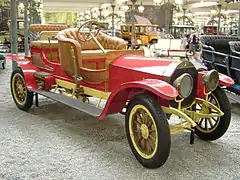 1905 Mercedes 28/50 PS double phaeton
1905 Mercedes 28/50 PS double phaeton_had_besprekingen_met_Kiesinger_te_Bonn%252C_lijfwacht_Presid%252C_Bestanddeelnr_920-2596.jpg.webp) Cadillac phaeton carrying President Johnson, 1967, nicknamed the "Queen Mary" by his Secret Service detail
Cadillac phaeton carrying President Johnson, 1967, nicknamed the "Queen Mary" by his Secret Service detail 1997 Chrysler Phaeton concept car
1997 Chrysler Phaeton concept car
Dual cowl phaeton
Specific use of the term phaeton is with the dual cowl phaeton, a body style in which the rear passengers were separated from the driver and the front passengers by a cowl or bulkhead, often with its own folding windshield.[9]
 1935 Duesenberg Model SJ LaGrande Dual Cowl Phaeton
1935 Duesenberg Model SJ LaGrande Dual Cowl Phaeton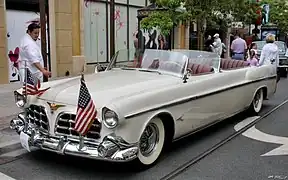 1956 Chrysler Imperial Parade Phaeton
1956 Chrysler Imperial Parade Phaeton
Decline in popularity
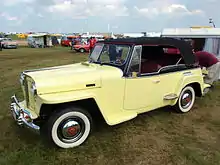
The phaeton and the touring car were popular up to the 1930s, after which they were largely replaced by the convertible, which also had a retractable roof, but also included side windows so that the car could be completely enclosed.[10]
The Willys-Overland Jeepster was the last true phaeton produced by a major US automaker,[11] and was introduced ten years after the previous phaeton to be offered by an American manufacturer.[12] The post-World War II demand for automobiles - of any description - was an opportunity for Willys-Overland to build on the Jeep's military recognition and they evolved the 1946 Jeepster two-door station wagon to the 1948 phaeton.[13] It provided a "Spartan but adequate appointments" that included hinged front door vent windows and plastic side curtains rather than roll-up glass windows.[13] Marketed from 1948 to 1951, the Jeepster phaeton was a rather expensive niche vehicle and "though admired by many, it was purchased by relatively few."[14]
In 1952, a year after Willys last offered the Jeepster, Chrysler Corporation built three Imperial Parade phaetons for ceremonial use, one by New York City, one by Los Angeles, and one intended for the White House, but ultimately used for events throughout the United States.[15] These were dual-cowl phaetons custom-built on stretched versions of the company’s Imperial Crown Limousine chassis.[16]
As a model name
In the late 1930s, Buick included a "convertible phaeton" body style, which was actually a four-door convertible, as the doors had roll up windows in them and the car could be fully closed.[17][18][19]
During the 1956 model year, Mercury marketed the four-door hardtop versions of its Montclair and Monterey models as "phaetons."[20][21]
In 2004, Volkswagen introduced a vehicle with the name Phaeton, which has a typical four-door sedan body style.[22]
 1934 Buick "convertible phaeton"
1934 Buick "convertible phaeton" 1956 Mercury Montclair Phaeton 4-door hardtop sedan
1956 Mercury Montclair Phaeton 4-door hardtop sedan 2013 Volkswagen Phaeton – a four-door hardtop sedan
2013 Volkswagen Phaeton – a four-door hardtop sedan
See also
References
- "Definition of Phaeton". The Free Dictionary. Retrieved 17 December 2017.
- Haajanen, Lennart W. (2017). Illustrated Dictionary of Automobile Body Styles (Second ed.). McFarland. p. 71. ISBN 978-1-4766-2404-4. Retrieved 17 December 2017.
- Terry, Christopher W.; Hall, Arthur (1914). "The Varieties of Motor Bodies". Motor Body-building in All Its Branches. London: E. & F. N. Spon. pp. 1–6. Retrieved 15 May 2014.
- Roberts, Peter (1974). "Carriage to Car". Veteran and Vintage Cars. London, UK: Octopus Books. p. 111. ISBN 0-7064-0331-2.
Phaeton – A light car with seats for two and the minimum of coachwork, similar to an early racing car. Phaetons could be double (four seats), triple, or closed. Sometimes also calles a spider, or spyder.
- "Definition of Phaeton". Merriam-Webster.com. Retrieved 17 December 2017.
- "Phaeton vs. Convertible?". Jalopy Journal - The H.A.M.B. Retrieved 22 December 2020.
- Gove, Philip Babcock, ed. (1966). Webster's Third New International Dictionary of the English Language, Unabridged. Vol. L–Z. Springfield, Mass.: G & C Merriam. p. 2417. ISBN 0-7135-1037-4.
- Culshaw, David; Horrobin, Peter (2013) [1974]. "Appendix 5: Coachwork Styles". The complete catalogue of British Cars 1895 - 1975 (E-book). Poundbury, Dorchester, UK: Veloce Publishing. pp. 482, 484. ISBN 978-1-845845-83-4.
Particular names originally associated with the Tourer tradition were Tonneau and Phaeton, the latter revived many years later, mainly in the United States up to the Second World War.
- Schreiber, Ronnie (11 August 2015). "Nothing Arrives in Style Like a Dual Cowl Phaeton". The Truth About Cars. Retrieved 22 December 2020.
- Taylor, Thom (16 May 2018). "Sure, phaetons are fabulous; just don't try riding in the back seat". Hagerty. Retrieved 22 December 2020.
- Matar, George (December 2005). "1948-1951 Jeepster". Hemmings Classic Car. Retrieved 11 December 2012.
- Brown, Arch (1994). "Chapter Four – Postwar Plans for Willys: 1945-52". Jeep: The Unstoppable Legend. Lincolnwoood, IL: Publications International. p. 76. ISBN 0-7853-0870-9.
But it was an open car—the first American phaeton in a decade—and it certainly had a sporty flair.
- "1949 Willys Jeepster Phaeton". Christies. 15 August 1998. Retrieved 22 December 2020.
- The Auto Editors of Consumer Guide (30 October 2007). "Introduction to the 1967-1973 Jeepster Commando". HowStuffWorks.com. Retrieved 22 December 2020.
- Siler, Steve (19 February 2019). "Chrysler Imperial: The Most Beautiful Presidential Limo in History". Car and Driver. Retrieved 22 December 2020.
- Heinzman, Paul F. "Imperial Parade Phaeton". teamchicago.com. Retrieved 22 December 2020.
- "Buick brochure". Img.inkfrog.com. Archived from the original on 17 May 2014. Retrieved 15 May 2014.
- Gunnel, John (2004). Standard Catalog of Buick 1903-2004. Krause Publications. pp. 40, 41, 43, 45, 47–63. ISBN 0-87349-760-0. Archived from the original on 19 September 2016. Retrieved 11 December 2012.
- McCourt, Mark J. (March 2020). "The 1938 Buick Century Convertible Phaeton offers great bang for the buck". Hemmings Motor News. Retrieved 22 December 2020.
- "Four-door hardtop is the newest member of 1956 Mercury line". Popular Science. 168 (1): 136. January 1956. Retrieved 15 May 2014.
- "1956 Mercury Hardtops brochure (Meet Mercury's new fleet of low-siluette hardtops ... featuring glamorous, new 4-DOOR Phaetons)". oldcarbrochures.com. Retrieved 22 December 2020.
- Joseph, Jacob (22 July 2012). "Biggest Automotive Missteps: Volkswagen Phaeton - The "Peoples' Car" brand simply couldn't get away with a full-blown luxury sedan". CarBuzz. Retrieved 22 December 2020.